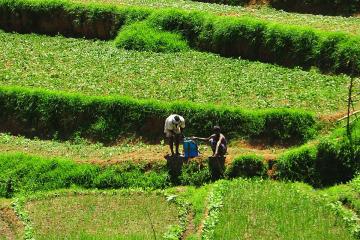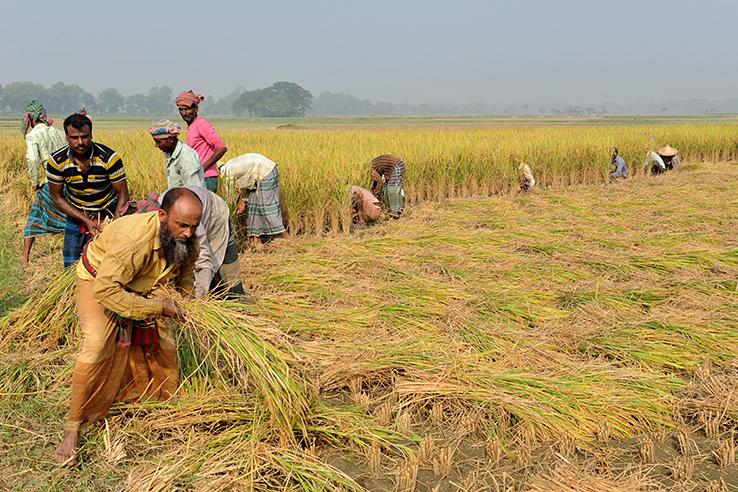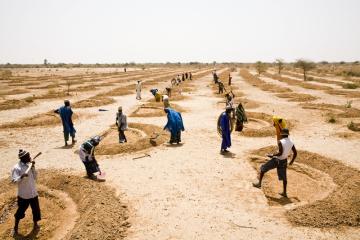
Building farmers' resilience to climate change

Résumé
Small-scale farmers in low- and middle-income countries are important to global food security, yet their livelihoods and welfare are extremely vulnerable to climate change. Extreme weather events, such as droughts or rainfall shocks, are increasing in frequency, intensity, and duration because of climate change, increasing volatility in small-scale farmers’ production.1 Farmers in sub-Saharan Africa, Southeast Asia, and Central and South America are likely to experience yield losses due to weather shocks and are among the most food insecure populations in the world.2 Building small-scale farmers’ resilience requires both supporting their livelihoods through increased production as well as their well-being through broader social assistance.
When farmers experience lower yields and profits due to weather shocks, they may be forced to cope with these impacts in ways that damage their livelihoods and well-being in the longer term. For example, after a shock, they may sell assets, such as livestock, to meet immediate consumption needs, impacting their ability to generate income from livestock sales or products. They may also reduce their food consumption, which can have detrimental effects on nutrition, especially for children. As such, higher average incomes can help farmers cope with more volatile weather in less damaging ways.
A review of ten randomized evaluations [1] [2] [3] [4] [5] [6] [7] [8] [9] [10] and three [11] [12] [13] quasi-experimental studies shows that certain resilient agricultural technologies and practices help farmers maintain [3] [8] or increase yields [1] [5] [6] and maintain or increase profits [1] [5] [6], but they may sometimes need complementary interventions to build their resilience [2] [4] [7] [9] [10] [11] [12] [13]. Social assistance, such as cash transfers, can help farmers maintain a minimum level of consumption, avoid selling assets, and enable economic diversification in the face of intensifying and more frequent weather shocks. Having more than one way to earn income gives farmers multiple alternatives for meeting their basic needs. As such, policymakers should potentially consider incorporating social assistance programs, like cash transfers and other livelihood support programs, into technological agriculture programs to sustain farmers’ income through the ups and downs of production.
Résultats
Agricultural technologies and practices strengthened farmers’ resilience to climate change without penalizing yields, in some cases enhancing productivity.
Five studies showed that farmers who used new agricultural technologies or practices avoided yield losses from weather shocks [3] [8] and/or increased their yields [1] [5] [6], thereby improving their resilience to the shocks. When shocks did not occur, farmers did not experience lower yields for using the climate-resilient technology compared to traditional methods or inputs. For example, in Bangladesh, where farmers rely on groundwater extraction for rice cultivation, frequent tidal floods damage crops by raising groundwater salinity. Farmers who adopted flood-saline-resilient seeds for lentil, mung bean, mustard, sesame, or wheat did not experience a decline in crop yield from a saline flood, while those who were not offered improved seeds faced yield declines of 19 percent [8].
In all cases where farmers increased their yields, they did so by increasing investment in complementary inputs [1] [5] [6]. In India, farmers were offered a flood-tolerant rice variety called Swarna Sub-1 in a mini-kit containing information on the seeds’ benefits. Farmers who were offered flood-tolerant seeds were more likely than those who did not to undertake productivity-enhancing practices (e.g., a more labor-intensive manual transplantation method), use higher levels of complementary inputs like fertilizers, and cultivate additional land. These decisions led to an increase in rice yields of about 10 percent in both flood and non-flood years compared to farmers who were not offered the flood-tolerant seeds [6].
Farmers are more likely to take up resilience-building agricultural technologies in seasons when they experience weather shocks because the benefits are made evident. However, more research is needed on how to address the time-varying barriers to uptake.
Building resilience often requires farmers to make forward-looking actions, such as planting drought- or flood-tolerant seeds or purchasing weather index insurance at the start of the season (existing evidence on the take-up and efficacy of index insurance is summarized here). In addition, farmers may not see the benefits of these resilient technologies at harvest if they do not experience a negative weather shock when they try the new technologies, which can discourage adoption. Three studies that tested technology uptake in both shock and non-shock seasons found that farmers who did experience shocks while experimenting with a resilient technology or practice were more likely to continue purchasing or using it compared to those who did not experience such shocks [1] [3] [8]. In Tanzania and Mozambique, farmers who tested drought-tolerant maize seeds went on to purchase more seeds the next year if they had experienced a drought, whereas those who used the drought-tolerant seeds but did not experience droughts did not increase spending on inputs the following year [3]. This suggests that because farmers who witnessed the performance of the shock-adapted technology under a shock could assess the benefits of adoption, they were more likely to continue to adopt in future seasons.
In contexts where individuals have a good understanding of their own vulnerability to climate change, they may be more likely to take up technologies. In one study in Niger, where farmers face some of the highest rates of soil degradation in the world, some farmers were offered training to build rainwater harvesting pits that increase water retention in the soil. They increased their adoption of the practice by 91 percentage points, compared to 4 percent adoption rates among households who did not receive the training (an increase of over 2,000 percent) [1]. In addition to the training, a subset of farmers received cash transfers to help them afford the start-up costs of adopting the practice. However, these farmers were not more likely to adopt the technique than those who only received the training, suggesting that providing information on a relevant technique was sufficient to incentivize farmers to take up the practice and cash transfers were not needed as an extra incentive. Policymakers should prioritize tailoring interventions to the specific vulnerabilities reported by farmers in their local contexts.
As a complement to these forward-looking actions, farmers can adopt financial tools, like guaranteed credit, after a weather event has occurred to cushion the impacts of a shock. In Bangladesh, farmers were randomly offered and preapproved to take emergency loans after a flood to help compensate for crop loss and damage. Twice as many farmers requested an emergency loan in years when extreme floods took place, compared to non-flood or less extreme years [9]. Because post-shock solutions do not require large investments of time, labor, or money before the shock, they can complement technologies deployed before the start of the agricultural season to reduce the impact of a weather shock. Other simple financial technologies, like mobile money and bank accounts, have also been shown to provide resilience.
Resilience-building technologies led to increased profits in some cases, but more research is needed to understand the circumstances in which they improve profitability over time.
Of the four studies that estimated farmers’ profits [1] [5] [6] [8], three found that farmers with access to resilience-building technologies increased their agricultural profits [1] [5] [6]. The profitability of a new technology depends on many factors, including costs, like labor or buying new tools, and farmers’ ability to sell their yields to generate revenue. In the aforementioned study in Niger, researchers calculated that farmers’ costs were approximately US$30 in the first year when households constructed the pits and fell to around US$4 in subsequent years when the pits required little further maintenance. Over the next two years, farmers could move degraded land back into production, improve soil quality, and increase their total agricultural production. This resulted in an increase in revenue of 10–13 percent (US$34 in the first year and US$37 by the third year). Profitability also rose by US$3 in the first year, with further increases in subsequent years due to falling costs [1]. Given the multitude of factors that affect farmers’ profitability over time, long-term measurement is needed to understand the full impact of adopting new technologies and practices.
Long-range, seasonal weather forecasting, while an understudied tool, is also showing promise in informing farmers’ investment decisions, enabling them to reallocate resources at the beginning of the season in accordance with the forecast [4] [13]. In monsoon-prone India, having access to relatively high-accuracy forecast information about the onset of the summer monsoons allowed farmers to invest in cash crops and increase input expenditures under good forecasts or to cultivate less land under bad forecasts. These adjustments depended on how the forecast information compared with farmer expectations. Immediate impacts on agricultural profits were negative, on average, likely because farmers diversified into other sources of income. However, more work is needed to document how these effects evolve over time [4]. As weather patterns shift, forecasts may help farmers to tailor investments and increase profits, warranting further long-run research.
Social assistance programs can complement resilience-building agricultural technologies to help farmers smooth consumption and avoid selling productive assets after experiencing a weather shock.
Of the five studies that evaluate agricultural technologies and practices [1] [3] [5] [6] [8], only two measured impacts on farmers’ consumption or food security [1] [3], and none reported on asset sales. In one case, farmers offered a drought-tolerant seed in Tanzania and Mozambique could not maintain their consumption during a severe drought, despite avoiding yield loss, implying that they still had to decrease spending to finance future agricultural investment [3]. Cutting consumption or selling productive assets may help households cope with immediate impacts of weather shocks, but they can also have negative long-term consequences. Because consumption, food security, and asset ownership are central to a household’s ability to cope, a program that does not collect data on these factors cannot holistically measure impacts on small-scale farmers’ resilience.
Social assistance programs, like cash transfers and bundled anti-poverty programs known as graduation models, can help farmers avoid having to sacrifice their immediate welfare in response to a weather shock. In five studies where farmers received traditional cash transfers, anticipatory cash transfers (which are sent before a forecasted weather shock), lump-sum grants, or graduation models, households increased [2] [10] or were less likely to cut their consumption [7] [11] [12]. In three of these five studies, households were more likely to keep productive assets like livestock during and after a shock [7] [10] [11]. In Zambia, farming households received monthly unconditional cash transfers large enough to cover the cost of one meal per day for all the household members for the month. Households who received the transfer increased their total consumption by roughly 20 percent, and in the event of a drought or flood, their consumption was 3 percent higher than those who did not receive a transfer but experienced a shock [2].
Graduation models, which go beyond simply transferring cash, can provide additional support for farmers vulnerable to weather shocks. In Ethiopia, farmers who were enrolled in a preexisting national program providing cash or food transfers to rural, drought-vulnerable households received a light-touch graduation model, including livelihoods training, home visits sharing information on nutrition and water, sanitation, and hygiene, and a lump-sum, in-kind transfer in the form of poultry or equivalent amount in cash. When households experienced a drought, those who were offered only the preexisting cash transfer experienced a 36 percent increase in self-reported food insecurity compared to those offered the light-touch graduation model. Households that received the additional graduation model leveraged the added resources to cushion the impacts of the shock, maintain their consumption, and reduce the likelihood of selling assets [7].
Cash transfers and livelihood interventions are just a few of the social assistance tools under the broader umbrella of social protection that can enhance resilience, particularly in instances where farmers are unlikely to take up resilience-building technologies or in areas with limited nonagricultural income opportunities. They can even affect agricultural activities, though this is an open area of research. In two of the studies on cash transfers that measured use of agricultural inputs, farmers who received social assistance increased their use of productive inputs like fertilizer, of which one found an increase in yields [2].
Social assistance programs also bolster farmers’ resilience by enabling them to pursue alternative sources of income. Understanding how these programs work at scale is an important next step.
In three [10] [11] [12] out of four studies [7] [10] [11] [12] on cash transfers or livelihood interventions where income diversification was measured, participating farmers maintained or expanded income-generating activities outside of agriculture compared to those who did not receive support. In Nicaragua, a one-time cash transfer for the purpose of income diversification, added onto a regular cash transfer program, better prepared agricultural households to engage in nonagricultural self-employment compared to those who did not receive any support when shocks hit. Other households who received vocational training alongside a regular cash transfer leveraged new skills when shocks hit and increased their likelihood of migrating for nonagricultural work [10]. In contrast, farmers who received the light-touch graduation model in Ethiopia did not diversify their income sources because nonagricultural activities were virtually nonexistent in the rural area [7].
While agricultural technologies and practices can help farmers maintain and even increase yields and profits, climate change will continue to exacerbate weather shocks, impacting their food insecurity and economic vulnerability. Policymakers have an opportunity to experiment at scale to understand how social assistance can be combined with resilience-building agricultural technologies to secure farmers’ livelihoods and well-being.
Abdul Latif Jameel Poverty Action Lab (J-PAL). 2024. "Building farmers' resilience to climate change." J-PAL Policy Insights. Last modified September 2024.
Intergovernmental Panel on Climate Change (IPCC). 2022. “Summary for Policymakers.” In Climate Change: Impacts, Adaptation and Vulnerability, edited by Hans-O. Pörtner, Debra C. Roberts, Elvira S. Poloczanska, Katja Mintenbeck, Melinda Tignor, Andrés Alegría, Marlies Craig et al., 3–34. Contribution of Working Group II to the Sixth Assessment Report of the Intergovernmental Panel on Climate Change. Cambridge, UK and Ney York, NY, USA: Cambridge University Press.
Aker, Jenny C., B. Kelsey Jack. 2023. “Harvesting the Rain: The Adoption of Environmental Technologies in the Sahel.” Review of Economics and Statistics (December): 1–52.
Research Paper | J-PAL Evaluation Summary
Asfaw, Solomon, Alessandro Carrarob, Benjamin Davisa, Sudhanshu Handac, and David Seidenfeld. 2017. “Cash Transfer Programmes, Weather Shocks and Household Welfare: Evidence from a Randomised Experiment in Zambia.” Journal of Development Effectiveness 9, no. 4 (September): 419–442.
Research Paper
Boucher, Stephen R., Michael R. Carter, Jon Einar Flatnes, Travis J. Lybbert, Jonathan G. Malacarne, Paswel P. Marenya, and Laura A. Paul. 2024. “Bundling Genetic and Financial Technologies for More Resilient and Productive Small-Scale Farmers in Africa.” The Economic Journal (February).
Research Paper
Burlig, Fiona, Amir Jina, Erin M. Kelley, Gregory Lane, and Harshil Sahai. “The Value of Forecasts: Experimental Evidence from Developing-Country Agriculture.” Working Paper, January 2024.
Working Paper
Emerick, Kyle, Alain de Janvry, Elizabeth Sadoulet, and Manzoor Dar. 2016. “Technological Innovations, Downside Risk, and the Modernization of Agriculture.” American Economic Review 106, no. 6 (June): 1537–1561.
Research Paper | J-PAL Evaluation Summary
Fishman, Ram, Xavier Giné, and Hanan Jacoby. 2023. “Efficient Irrigation and Water Conservation: Evidence from South India.” Journal of Development Economics 162, no. 103051 (May).
Research Paper
Hirvonen, Kalle, Daniel Gilligan, Jessica Leight, Heleene Tambet, and Victor Villa. “Do Ultra-Poor Graduation Programs Build Resilience against Droughts? Evidence from Rural Ethiopia.” IFPRI Discussion Paper, November 2023.
Working Paper
Kondylis, Florence, John Ashton Loeser, Mushfiq Mobarak, Maria Ruth Jones, and Daniel Stein. “Learning from Self and Learning from Others: Experimental Evidence from Bangladesh.” World Bank Policy Research Working Paper #10545, August 2023.
Working Paper
Lane, Gregory. “Adapting to Floods with Guaranteed Credit: Evidence from Bangladesh.” Working Paper, October 2023.
Working Paper
Macours, Karen, Patrick Premand, and Renos Vakis. 2022. “Transfers, Diversification and Household Risk Strategies: Can Productive Safety Nets Help Households Manage Climatic Variability?” The Economic Journal 132, no. 647 (October): 2438–2470.
Research Paper
Pople, Ashley, Ruth Hill, Stefan Dercon, and Ben Brunckhorst. “Anticipatory Cash Transfers in Climate Disaster Response.” CSAE Working Paper Series, July 2021.
Working Paper
Premand, Patrick and Quentin Stoeffler. 2022. “Cash Transfers, Climatic Shocks and Resilience in the Sahel.” Journal of Environmental Economics and Management 116, no. 102744 (October).
Research Paper
Rosenzweig, Mark and Christopher Udry. “Assessing the Benefits of Long-Run Weather Forecasting for the Rural Poor: Farmer Investments and Worker Migration in a Dynamic Equilibrium Model.” NBER Working Paper Series 25894, May 2019.
Working Paper
